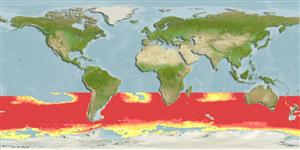Classification / Names
Common names from other countries
Main reference
Size / Weight / Age
Max length : 16.2 cm SL male/unsexed; (Ref. 5182)
Length at first maturity
Lm ?, range 13 - ? cm
Environment
Marine; bathypelagic; oceanodromous (Ref. 51243)
Climate / Range
Deep-water, preferred ?; 21°S -
Distribution
Circumglobal from the Subtropical Convergence to south of the Antarctic Polar Front at Weddell-Scotia confluence and northern reaches of Ross Sea, and extending northwards to 21°S in meridional currents.
Countries | FAO areas | Ecosystems | Occurrences | Introductions
Short description
Dorsal
spines
(total): 0;
Dorsal
soft rays
(total): 13-16;
Anal
spines: 0;
Anal
soft rays: 15 - 19;
Vertebrae: 36 - 38. 14-16 AO photophores; 9-12 tooth patches on the lower limb of the second gill arch; 34-38 lateral line organs (Ref. 36121). Pectoral fins relatively long and well developed in juveniles (easily visible in individuals up to about 6 cm SL), progressively becoming relatively shorter, with thicker rays, and covered by skin (in various stages of becoming vestigial between 5-8 cm SL). Adults (greater than 8 cm SL) with vestigial rays buried in skin and not externally visible unless skin abraded or otherwise torn (Ref. 36121).
IUCN Red List Status (Ref. 115185)
Threat to humans
Harmless
Human uses
More information
Age/SizeGrowthLength-weightLength-lengthLength-frequenciesMorphometricsMorphologyLarvaeLarval dynamicsRecruitmentAbundance
Tools
Special reports
Download XML
Internet sources
Estimates of some properties based on models
Phylogenetic diversity index
PD50 = 0.5000 many relatives (e.g. carps) 0.5 - 2.0 few relatives (e.g. lungfishes)
Trophic Level
3.2 ±0.4 se; Based on size and trophs of closest relatives
Resilience
Medium, minimum population doubling time 1.4 - 4.4 years (Preliminary K or Fecundity.)
Vulnerability
Moderate vulnerability (40 of 100)
Price category
